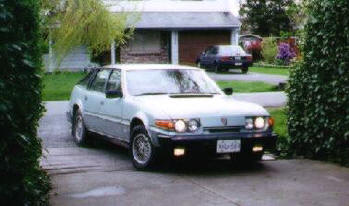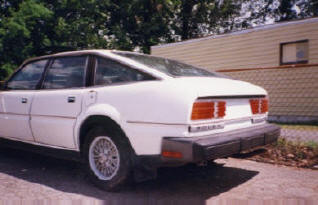Rover SD1 Story by Paul Bridger
Paul Bridger's
excellent pages were linked from my site and now seem to have
disappeared from the web. Below are cached pages that were left on my PC
and have been included in my site. If anyone knows where the original
pages now reside, could they tell me the URL so I can restore the
links.
The Rover Specialist Division 1
or SD1 as it later became known, was created by the combined talents of
Rover and Triumph engineers, with the styling being the responsibility of
David Bache. Its' role was to replace both the Triumph 2000/2500/2.5PI and
Rover (P6) 2000/2200/3500 ranges. Its' main features were that it combined
the looks of a Ferrari Daytona with simple and basic (some people might
call old fashioned) mechanics.
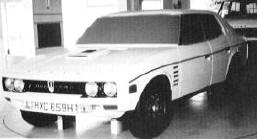 |
Work really started independently on
the replacements for the Triumph 2000 and Rover 2000 in 1969, but
the Rover engineers were also already working on the larger 31/2 Litre (P5) replacement and this new P8 (see
photo) was given more importance when the Leyland Company joined
forces with the British Motor Corporation (BMC) to create British
Leyland (BL). The team did concentrate on this large boxy style
replacement for the P5 (the standard vehicle used by the British
Government throughout the seventies), but the model was soon deemed
to be too close in competition for the new Jaguar XJ saloon (another
manufacturer in the great BL empire) and the concept was quietly
dropped in 1971, but not before it had progressed to being nearly
production ready. |
|
Many people were involved in the
development of the SD1 notably (see photo) from left to right Mike
Lewis (Chief Engineer), David Bache (Head of Styling), Spen King
(Director of Engineering), Gordon Bashford (SD1 Design).
Some of the others involved were Geoff Purkis, Jim Parkinson
and David Eley (the last pair were responsible for the 2300/2600
engine and the manual gearbox and rear axle) |
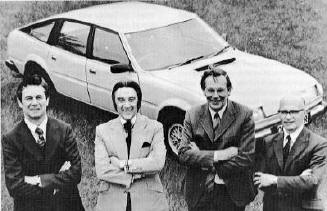 |
The
Triumph 2000 range received a makeover in 1969 (receiving a new front,
rear and interior), which updated its' early sixties design, the proposal
to produce a Stag V8 engined 3000 model, was luckily resisted (just think
of the warranty claims that would have created), while the Rover 2000
range was given a mild update in 1970 (new front grill and instruments).
These changes were deemed enough for the cars to continue for at least 5
years.
Early in 1971 the management/product department at BL
suddenly realised that it did not make any sense for there to be any
direct internal competition between models in the vast range of cars they
produced and for there to be as much major component sharing as possible
(Sounds a bit like the present VW groups policy with itself, Seat, Skoda
& Audi.)
The models produced at that time by BL (with their
introduction dates) and proposed future models
1959 Mini (with newly
styled 1969 Clubman)
1962 1100/1300 (range to die in 1973)
1971
Allegro (Supposedly the 1100/1300 replacement, but sharing Mini or Maxi
mechanics)
1961 MG Midget (to save costs and continue exports to the
USA, was to share its engine and gearbox with the Spitfire)
1962
Triumph Spitfire
1965 Triumph 1300/1500 (set to become the Dolomite and
Toledo range when it started sharing its mechanics with the Marina and
TR7)
1969 Maxi
1970 Marina
1964 1800/2200 (its' replacement the
1975 Princess being well under way)
1962 MGB (Due to receive the new O
series OHC engine later in the late 1970s)
1968 Triumph TR6 (its'
replacement the Dolomite based 1976 TR7 nearing completion)
1963 Rover
2000/3500
1963 Triumph 2000/2.5PI
1970 Triumph Stag (sharing most of
its mechanics with the 2.5PI)
1961 Jaguar E-Type(its' replacement the
XJ12 based 1975 XJS being developed at the time)
1958 Rover 31/2 Litre(Production now very limited and soon to
cease)
1968 Jaguar XJ series
1968 Daimler Limousine (based on the
1961 Jaguar MkX)
Other than the Midget and Spitfire, the Rover
2000/Triumph 2000 range were the only models in direct competition with
each other, being almost the same size and price, having similar
performance they also appealed to the same buyers and unfortunately there
was no chance of any component sharing between these models (The Triumph
2000 range did shared major components with the TR6 and Stag).
The
thinking at the time was that if one new model were to replace these 2
cars, if it was cheaper to produce, easier to build and appealed to the
same buyers then at last at least one model in the BL range might make
some money for the shareholders. (Large cars normally equal large
profits)
So Rover project P10 (as the P6s replacement had been
known) was renamed RT1 (for Rover Triumph first joint project), but within
2 months the project was renamed SD1 as Jaguar, Rover and Triumph were now
grouped together as the Specialist Division.
A brand new purpose
built factory was built at Solihull to produce the SD1 and was at the time
the most modern in Europe. The factory was built to be able to reach the
optimistic production figures set by BL, but was really far to large and
some say not built quite right. There are still rumours that the
extraction fans in the paint shop sucked air and grit in rather than
taking fumes out.
To get the SD1 into production over £100 million
of tax payers money was donated by the British Government (as
unfortunately for some years British Leyland had been losing millions and
by 1975 was bankrupt. Nationalisation was seen as the only answer and the
Government then start pouring money in).
£95 million was spent on
development, tooling and the construction of the factory alone.
The
decision to produce a five door hatchback was taken at an early stage, but
as late as 1975 doubt started to creep in. The likeliness of losing the
important executive saloon and estate market that the Triumph 2000 and P6
dominated, with a hatchback made a proposal to update the Triumph 2000
range of 4 door saloon and 5 door estate with the Austin 2200 E6 straight
6 engine and sell this along side the SD1 for the foreseeable future seem
sensible. So at least one prototype was built to assess the possibility
(it worked well, but was later thought unnecessary but the work done would
later prove useful on export models)
The SD1 body shell was
designed to be light for its size, with substantial central safety cell
for the passenger compartment while both areas in front of the front
wheels and behind the rear wheels were crumple zones designed to fold up
in a major accident (this would lessen the damage done to the occupants
should the car crash). The under body being very similar to the Triumph
2000 incorporating the same type of inner wheelarch design and floor pan
stiffening.
Mechanically a revised P6 V8 engine (improved cylinder
heads with better valve gear plus a standard type rear crankshaft seal
instead of the previous rope type of seal), a new 5 speed manual gearbox
(later used in TR7 and XJS and numerous Land Rovers), a well located live
(non-independent) coil sprung rear axle were fitted. At the front revised
Triumph Dolomite/2000 Macpherson struts were used.
Click here
for the V8 story
|
On release the SD1 was extremely
popular, with many second hand models being sold for more than new
cars as the waiting list was measured in months. Motorists and
journalists approved of the sporty handling, the composed ride and
the modern design of the exterior and interior. It was voted Car of
the Year and received more awards than any car had previously (I
have not been able to find another car since that has awarded so
many trophies for its design).
|
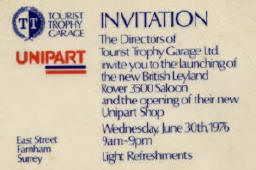 |
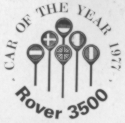 |
In late October 1977 the new 6
cylinder models 2300/2600 were released and the Rover 2000 ceased
production. But the Triumph range continued through into 1978 when
because of the SD1s popularity it was killed off.
|
Click here for
the 6 cylinder story
Things then started to go wrong,
poorly applied paintwork, various water leaks, failure of the self
levelling rear suspension units, gearbox problems, electrical problems
& general poor build quality became evident to the Rover dealers and
various motoring magazines. The company fleet buyers and public soon
noticed as well and sales dropped like a stone. Warranty claims started
mounting up. Luckily at the same time fewer SD1s were being built due to
the numerous strikes at the BL factories so the late 1980/1990s problem of
thousands of complete cars sitting in fields did not happen (the cars were
incomplete). Some SD1s spent 6 to 8 weeks being built according to the
production records (Some of which is viewable Click
Here)
The Range now included 2300,
2600, 3500 models and was available with optional Dunlop Denovo tyres
claimed to run deflated for 100 miles at 50 mph, making a spare
unnecessary and gaining more luggage space.
The next model of SD1
to be released was the V8S in 1979. This was essentially the 3500 model
but with an even more luxurious interior with corduroy type of seat trim
and most of the optional equipment standard. Throughout the range
different exterior colours were now available and the traditional type of
plastic Rover badge made a return in place of the metal skeletal design
seen on the original SD1's. Also the front panel above the bumper now
incorporated an air intake. This was mainly for the benefit of the air
conditioned cars but also improved cooling for all the other
models
| The ranges'
first facelift |
The SD1 sales did not
pick-up even after the 1979 Buy British Campaign and the Cars with the
Gremlins removed Advertisements, these just reinforced the publics
disappointment with the lack of build quality in the entire BL range. So
in an attempt to generate a revival in sales Rover upgraded the entire
range in 1980. All specifications were increased, the major changes appear
to be better (more expensive looking and feeling) material covering the
seats and illuminated switches in the instrument pod also headlight
washers and sunroofs were available for most of the range. The 2300 was
joined by the 2300S & the 2600/3500 now became the 2600S/3500SE. The
V8S was replaced with the even more luxurious Vanden Plas (named after the
coachwork company owned by BL, although no SD1 ever appears to have gone
to Vanden Plas to be upgraded/converted).
In 1981 an important
event occurred with regard to quality, all production ceased at purpose
built Solihull factory and production moved to Cowley. This was very
important as these later cars and later 1982 onwards(as they are now
known) Series 2 cars appeared to be much better made, with most of the
niggling faults solved and paint quality improved dramatically.
Land Rover moved into the Solihull factory and did not seem to
suffer the same quality problems as the SD1 production line. Now following
their takeover of Land Rover, Ford own the Solihull Factory. This is
ironic as the original purpose of this factory was to produce the Ford
Granadas' main European rival
Since the SD1 first appeared in 1976
it was quickly realised its performance car potential, notably Janspeed
and Turbo Technics who offered a twin turbo conversion giving a
performance boost to the standard V8 engined cars and single turbo
conversion to the 2600, which raised the top speed to over 130mph, with
the important 0-60mph acceleration time being reduced by over 1 second
from standard.
Meanwhile Rover were creating their own version of
a performance SD1.
Click here
to read about this first performance SD1
The prototype
car had Webers fitted in place of the SU carbs fitted to the standard car
and other modifications to produce a very rapid and thirsty car. Lessons
learnt from this car would be very worthwhile later on
| The SD1 gets
its' main face lift |
|
The biggest changes came to the SD1
range in 1982. Customers complaints had been noted since 1976 and
bought about a series of changes which resulted in what is now often
called the Series 2 models (or SD2 by parts manufacturers/motor
factors). |
 |
Although the basic
bodyshell was not altered, the most noticeably changes were seen at the
front with a new spoiler which was designed to help road holding and
reduce the drag cd by 0.02, a plastic air intake above the new wraparound
front plastic bumper, flush fitting headlights, new plastic bumpers, new
indicator lamps and stainless steel trim around the front lights. At the
rear the tailgate was altered and a new rear window glass fitted which
extended further down the tailgate by 5 inches, this incorporated as
standard a rear wiper (although this had been a dealer fit Unipart option
since 1980) which answered complaints about poor rearward vision, new
wheels were also seen with alloy wheels featuring on most of the range as
standard.
The interior was also changed after complaints about the
first cars being totally devoid of any real luxury features like wood or
even wood effect formica (as fitted to the Rover P6) . A large new
instrument pod featuring hi-tech electronic angular instruments instead of
the previous round instruments, with the volt meter being replaced with
either a digital clock or a trip computer. Wood did make a return to the
most of the ranges' interior either just on the doors or on the doors and
across the main dash board assembly. Also a new thicker rimed steering
wheel was fitted.
British Leyland officially became the Austin
Rover Group in 1982.
It was not only the looks that changed as
changes were made to the engines (with the fitment of automatic chokes,
solex carburettors and increased service intervals).
|
Also new was the 2000 model (with
Rover happily using the nostalgia of the old P6 to help sales)
fitted with the O series engine from the Morris Ital fitted with
twin carburettors and a
2400SD turbo diesel, this being fitted with
an Italian VM engine, making the SD1 the fastest diesel engined car
available at the time. This VM engine was later enlarged to 2500 cc
and fitted to numerous Range Rovers and the Rover 800. |
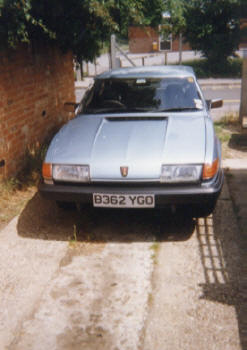 |
Also later in 1982
came the Vitesse. This was created due to the need for more power as Rover
was to go racing. And Rover was very serious about racing, it wanted to
win. The BL competition department based at Abingdon (home of MG) had been
closed in 1979 when its last vehicle the TR7 V8 was withdrawn from
rallying, So a new competitions department was set up called Motorsport.
One of Motorsports first cars was the SD1
This was followed
by some circuit racing SD1s, but to compete with Capris and BMWs more
power was needed.
For a few years the Rover V8 engine had been
fuel injected, mainly for emissions in the USA and Switzerland, and a
development of this TR8 based system was initially thought to be tunable
for performance. But it was soon totally redesigned and a Lucas badged and
produced, Bosch based system was created. As the race cars needed to be
production based so this system had to be seen fitted to the production
SD1. The Vitesse was released in October 1982 at the British Motor Show as
a limited edition, factory order model.
The car was distinguished
from lesser models by having larger 15'' lattice style alloy wheels,
lowered suspension, a large rubberised rear tailgate spoiler (which
lowered the drag cd by a further 0.02 and reduced rear end lift at speed)
and along each side the car screamed Vitesse in 6'' letters on the lower
part of the doors.
The model was to be named the Rapid, but Aston
Martin, who owned that name, objected, so BL used the name Vitesse
previous used on the successful Triumph Herald based range last made in
1971.
The Vitesse was the fastest Rover to date. Also at the time
it was the fastest five door production saloon car in the world.
Inside the interior was basically to Vanden Plas specification
(but available only in two tone grey) with the exception of unique bucket
seats trimmed in a similar material as used on the MG Metro. Although a
few Vitesse models did have these seats trimmed in leather, no doubt at
great expense.
In 1983 the Vitesse was classified as a standard
production model and was made available with automatic
transmission.
In 1984 the Vanden Plas model
received the Vitesse engine and this new flagship SD1, the Vanden
Plas EFi was launched. This model was the ultimate luxury model and
was always fitted with an automatic gearbox and remained at the top
of the range till the end.
|
Other changes that effected
the rest of the petrol engined range in 1984 were the fitment of SU
carburettors with electronic management, these replacing the Strombergs
used for the last 2 years
In 1985 indicator repeater lens were
fitted across the range and placed in the front wings between the wheel
arch and the front door. No more major changes appeared to be made until
production ceased in July 1986 (although quite a few cars were registered
in 1987).
The Rover 800 replacement was launched in 1986, this was
essentially similar to SD1 in looks (the rear hatch was designed to be the
same angle as the SD1s) with a floorpan of very similar design (maybe the
engineers were still dreaming of rear wheel drive)and was produced in
co-operation with Honda(who named their variant the Legend or Acura.)
Later this model received an even worst reputation than the SD1,
forcing Rover totally out of the USA market for the second time. The SD1
was thus the last British designed and built Rover and with the ceasing of
it's production so the ended another part of British
history.
Just over 300,000 SD1s of
all variants were produced between 1975 and 1986 compared with over
combined 600,000 of the Rover 2000/3500 and Triumph 2000/2500 ranges
produced between 1963 and 1978. This could be seen as a success or a
failure, but the lack of different body types defiantly had an adverse
affect on sales, maybe more than the atrocious build
quality
Paul Bridger's
excellent pages that have been linked form my site seem to have disappeared
from the web. These are cached pages that were left on my PC and have been
included in my site. If anyone knows where the original pages now reside
could they let me know the URL so I can restore the links.
Click here for: (unfortunately
these links do not work at the moment)
|




